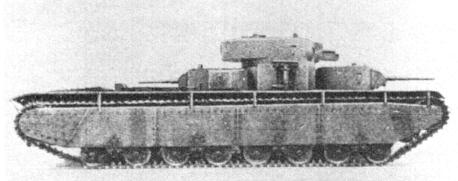

T-35 Model 1935. Note the cylindrical turret with overhang and the extended skirting armour.
First prototype of this land battleship was completed in July 1932 at the Bolshevik Factory and was put on trials at NIIBT in Kubinka in April 1933 before performing at the May Day parade in May of 1933. The 10 first production vehicles was completed in 1933, and the 10 vehicles in the second production batch which were completed later had a new turret. The standard production model did not enter production until 1935. The guns was arranged in the same way as they were on the T-32. The two 37mm antitank-guns were the same used by the BT-2, and the machinegun turrets was used by the T-37 and T-38 amphib tankettes. In addition, the T-35 had five extra machineguns. To employ all the armament a large crew was required, and the crew consisted of 10 men. Carrying 96 76.2mm shells, 220 37mm shells + an additional 10.000 shells to the machineguns. The suspension was protected by 10mm thick armour plates. The T-35 was powered by a 500hp M-17M engine, and used a 4/1 gearbox. The suspension consisted of units of two bogies each, and the bogie wheels were fitted with external rubber-tyres. The tank was also equipped with radio equipment, and some vehicles had a frame aerial around the main turret. During 1935, the T-35 was improved; suspension was improved, and the 37mm guns were replaced by 45mm guns. Fighting experience from the Finnish Winter War necessiated further alterations: some vehicles had the two machinegun turrets removed, and others were reported only having the main, and front subsidiary turrets mounting a 45mm gun and a machinegun. The final production models used during the Finnish Winter War were welded throughout.

T-35 Model 1938. Note the new sloping sided turret with welded armour and modified track and suspension skirts.

T-35 Model 1938 on parade in Moscow.
The only T-35 tanks encountered by the Germans were at Lvov, Poland, were they had run out of fuel. The result of the engagement is unknown. Some sources states that surviving T-35 tanks were used fighting alongside Siberian skitroops in the Battle of Moscow in late 1941, but few survived 1941. The T-35 was going to prove itself beeing poor both technically and tactically. When deployed, T-35s were allocated to the RGK (Supreme Command Reserve). During 1938, a group of engineers was taken from the Kirov-Zavod tank plant at Leningrad, and placed under the direction of Kotin and Dukhov, and were ordered by Stalin himself to develop a new multi-turreted heavy tank to replace the T-35 series. A super-heavy T-39 was designed, weighing 95.000kg. This was to be armed with a 152mm howitzer, a 107mm howitzer and a 45mm gun. It was to be powered by two engines providing a total of 1200hp, but it never reached the prototype stage.
BEHEMOTH! - Slovak troops investigating an abandoned T-35 Model 1935 outside Tarnopol, Summer 1941.

Germans posing in front of a captured T-35 Model 1935. I hope this photo will show you how BIG this bastard was!
The only T-35 (Model 1935) tank still existing,
exhibited at the Kubinka tank museum outside Moscow.
Photo provided by: George Mellinger.